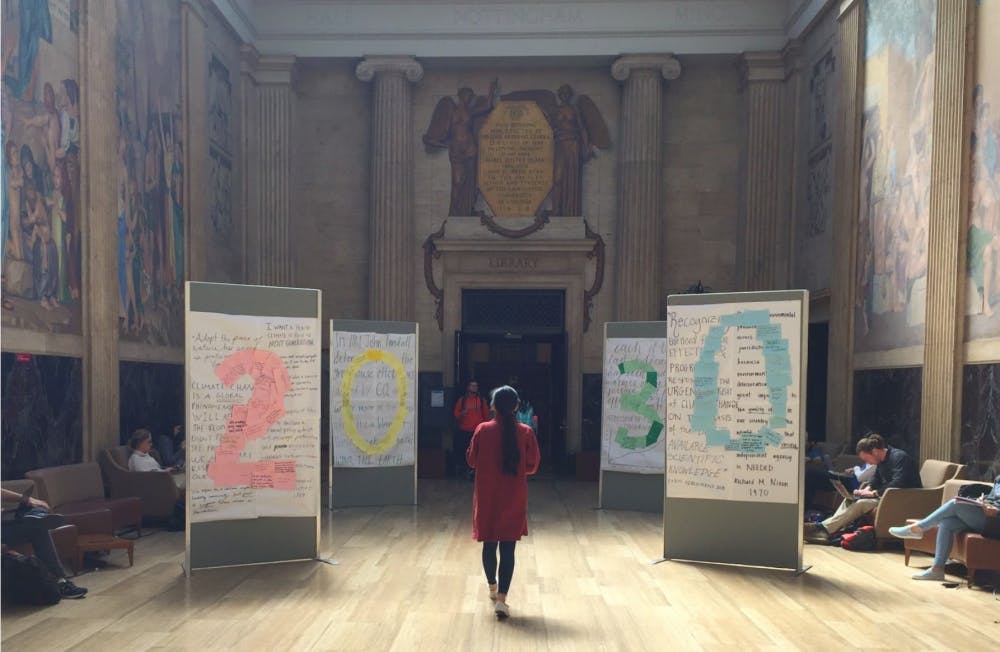For the second year in a row, Environmental Sciences Prof. Deborah Lawrence aimed to intersect the arts and sciences to inform the public about the changing planet. Through her course EVSC 1559, “Write Climate, Right Climate,” Lawrence helped students use literary, artistic and activist means to create a display in the Mural Room of Clark Hall to raise awareness for climate change. This semester is the first time the course has partnered with a local artist to create the culminating display.
“The goal is to try and use art to create some awareness around climate change, a commitment to do something about it and a sense of community,” Lawrence said. “You don’t want to do anything if you’re not feeling connected and if you don’t feel like it’s your job, so we try to take that message out and around Grounds.”
Lawrence’s course convenes in the spring semester, and for the past three weeks, her students tabled around grounds to collect the voices of 1200 of their peers on little pieces of paper.
“We’ve asked community members at U.Va. to write down … something about how they feel about climate change, what they’re doing about it, do they have questions, you know, their concerns,” said Amanda Nelson, the artist helping Prof. Lawrence and the class on this project. “It’s either a scientific statement, a policy statement or individual statement about climate change.”
Hannah Hervey, first-year College student in EVSC 1559, said that she appreciated getting to know what the University as a whole thinks about climate change. After reading these individual slips of paper, she felt that she was helping connect the community around this topic.
“I'm taking the individual thoughts and ideas from people that play some role in the UVa community and literally combining them all together to make a bigger statement about the environment,” Hervey said in an email statement sent to The Cavalier Daily. “[It] is not only a beautiful concept in itself but also symbolic of how we need to come together as a community on this issue if we want to make a significant change.”
The class changed its approach to addressing climate change this year by expanding its footprint with a two-step reveal as opposed to last year’s single Clark Hall display. Specifically, students worked alongside Nelson to artistically compile the University community’s notes into a preliminary “teaser” and plan to showcase their major installation at a surprise location on-Grounds on Earth Day, April 22.
The preliminary piece — found in the Clark Hall Mural Room — consists of four panels covered with policy statements and scientific investigations all relating to climate change. The community notes were incorporated into the panels by shaping them into numbers that read the year “2030.”
Nelson explained that this layout was significant to attracting the audience’s attention and inspiring them to think about their actions. She described the questions that inspired this layout.
“Is it next year that means it’s urgent, is it in the next 11 years, is it now?” Nelson said. “Is it a number, is it a phrase? What invites curiosity, but also empowers action?”
The display’s layout also complements the project’s goal of using impactful art to connect with community members but also to serve as a call to action for the urgency of climate change.
“We’ve tried to look at different websites and different texts — and how you present truth, you know, in science … without scaring people away,” Nelson said. “To try and invite conversation by trying to not be overly didactic but also not be binary. It’s not you are with us or you’re against us, it’s just let’s have a conversation because this is really important to me, and I feel it’s very urgent.”
Another way this project expanded from last year was with the formation of the Write Climate Club. Brian Hnat — a third-year College student and president of Write Climate who took EVSC 1559 last spring — talked about how it was difficult to maintain momentum of the productive class within the confines of a classroom.
“We realized that we needed a club to do the things that the class couldn’t do, which included being a little more politically active,” Hnat said.
The club published a website, maintains a social media presence, has led meetings to write to members of Congress advocating their support for the Green New Deal and plans to write on Beta Bridge soon. While the club has a sizeable cohort, Hnat said that that it is always welcoming passionate, new members.
In the future, Lawrence hopes to expand the model of Write Climate and her course to other schools and campuses. Lawrence aims to first reach local high schools next year to teach them how to create similar projects or even start their own club chapters.
Regardless of her target audience, she wants everyone to be mindful of how their actions contribute to the changing planet.
“Ultimately, we want to write climate for the right climate,” Lawrence said. “It’s something we wanted people to do and think about everyday.”
As a scientist working with an artist and University students, Lawrence hopes the project’s emphasis on interdisciplinary collaboration persists through the years.
“Science can only tell us so much about where we need to go, and ultimately, the conversation on climate change has to be bigger than just the science,” Lawrence said. “We have to engage people in a way that gets them thinking and gets them reflecting on what they value.”







